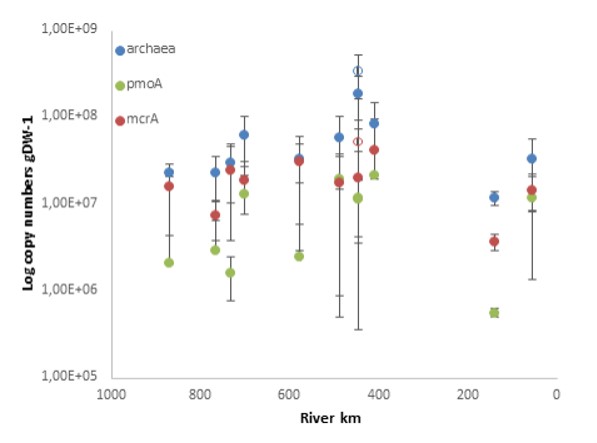
Authors
Methane (CH4) is an important atmospheric trace gas mostly released from wet anoxic soils and sediments. While many studies have focused on relatively homogenous environments like rice fields and lake sediments, the changing contribution of heterogeneous sediments e.g. along the longitudinal profile of a rivers has not been covered very frequently. Here we investigated sediment samples from 11 locations of the Elbe River. Sediments were incubated to measure methanogenic/methanotrophic potentials and contribution of individual methanogenic pathways using isotope analysis of δ13C. Additionally, we determined the diversity of the methanogenic communities (analysis of T-RFLP targeting the mcr-A gene in the sediment samples), while abundances of archaea, methanogens and methanotrophs were determined by qPCR. The CH4 production was detected in six samples (out of 11 examined) and ranged from 0.12 to 644.72 nmol gDW-1 d-1. Methanotrophy was found in all examined sediment samples and ranged from 654 to 10,875 nmol gDW-1 d-1. Abundance of methanogens and methanotrophs (Mcr-A and pmo-A gene copy numbers) was not significantly different and quite stable around 106 to 107 copies gDW-1. The group specific qPCR showed high fluctuations, while the highest counts were reported for Methanomicrobiales and Methanosarcinales (105 to 108 copies per gram dry sediment), followed by Methanobacteriales (103 to 105 copies per gram dry sediment). A significant proportion of unidentified methanogens was found in almost every locality. Isotope analysis of δ13C showed that (CH4) is produced mainly by hydrogenotrophic methanogens. We see no trend in the studied parameters along the Elbe River. The molecular data showed no spatial characteristics, while we found hotspots of the measured CH4 processes (CH4 production and oxidation) due to other local driving factors (e.g. carbon content). Thus, out results indicate that the observed variability of the CH4 production and oxidation rates is only indirectly linked to the presence or quantities of different microbial guilds.









